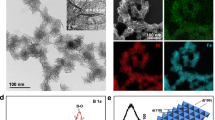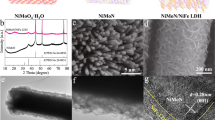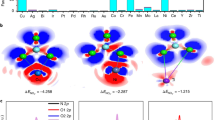Abstract
The electrochemical nitrogen reduction reaction (ENRR) can allow the production of ammonia from nitrogen and water under ambient conditions and is regarded as a sustainable alternative to the industrial Haber–Bosch process. However, electrocatalytic systems that selectively and efficiently catalyse nitrogen reduction remain elusive due to the strong competition with the hydrogen evolution reaction. Here, we report a strategy to simultaneously promote ENRR selectivity and activity using bismuth nanocrystals and potassium cations. Bismuth exhibits higher intrinsic ENRR activity than transition metals due to the strong interaction between the Bi 6p band and the N 2p orbitals. Potassium cations stabilize key nitrogen-reduction intermediates and regulate proton transfer to increase the selectivity. A high Faradaic efficiency of 66% and ammonia yield of 200 mmol g–1 h–1 (0.052 mmol cm–2 h–1) are obtained in aqueous electrolyte under ambient conditions. This strategy represents a general method to expand the library of catalysts and promoters for the selective electrochemical reduction of stable molecules.
This is a preview of subscription content, access via your institution
Access options
Access Nature and 54 other Nature Portfolio journals
Get Nature+, our best-value online-access subscription
$29.99 / 30 days
cancel any time
Subscribe to this journal
Receive 12 digital issues and online access to articles
$119.00 per year
only $9.92 per issue
Buy this article
- Purchase on Springer Link
- Instant access to full article PDF
Prices may be subject to local taxes which are calculated during checkout





Similar content being viewed by others
Data availability
The data that support the findings of this study are available from the corresponding author upon reasonable request.
Change history
08 March 2019
In the version of this Article originally published, all labels for the orange, blue and red trends in Fig. 3b read ‘BiNCs’, but the orange labels should have read ‘BiNPs’, and the blue ‘BiBPs’. This has now been corrected.
References
van der Ham, C. J. M., Koper, M. T. M. & Hetterscheid, D. G. H. Challenges in reduction of dinitrogen by proton and electron transfer. Chem. Soc. Rev. 43, 5183–5191 (2014).
Kyriakou, V., Garagounis, I., Vasileiou, E., Vourros, A. & Stoukides, M. Progress in the electrochemical synthesis of ammonia. Catal. Today 286, 2–13 (2017).
Shipman, M. A. & Symes, M. Recent progress towards the electrosynthesis of ammonia from sustainable resources. Catal. Today 286, 57–68 (2017).
Guo, C. X., Ran, J. R., Vasileff, A. & Qiao, S. Z. Rational design of electrocatalysts and photo(electro)catalysts for nitrogen reduction to ammonia (NH3) under ambient conditions. Energy Environ. Sci. 11, 45–56 (2018).
Cao, N. & Zheng, G. F. Aqueous electrocatalytic N2 reduction under ambient conditions. Nano Res. 11, 2992–3008 (2018).
Deng, J., Iñiguez, J. A. & Liu, C. Electrocatalytic nitrogen reduction at low temperature. Joule 2, 846–856 (2018).
Chen, J. G. et al. Beyond fossil fuel-driven nitrogen transformations. Science 360, eaar6611 (2018).
Ertl, G. Reactions at surfaces: From atoms to complexity. Angew. Chem. Int. Ed. 47, 3524–3535 (2008).
Appl, M. in Ullmann’s Encyclopedia of Industrial Chemistry (Wiley-VCH, Weinheim, 2006).
Skúlason, E. et al. A theoretical evaluation of possible transition metal electro catalysts for N2 reduction. Phys. Chem. Chem. Phys. 14, 1235–1245 (2012).
Montoya, J. H., Tsai, C., Vojvodic, A. & Nørskov, J. K. The challenge of electrochemical ammonia synthesis: a new perspective on the role of nitrogen scaling relations. ChemSusChem 8, 2180–2186 (2015).
Kordali, V., Kyriacou, G. & Lambrou, Ch. Electrochemical synthesis of ammonia at atmospheric pressure and low temperature in a solid polymer electrolyte cell. Chem. Commun. 1673–1674 (2000).
Lan, R., Irvine, J. T. S. & Tao, S. W. Synthesis of ammonia directly from air and water at ambient temperature and pressure. Sci. Rep. 3, 1145 (2013).
Chen, S. M. et al. Electrocatalytic synthesis of ammonia at room temperature and atmospheric pressure from water and nitrogen on a carbon-nanotube-based electrocatalyst. Angew. Chem. Int. Ed. 56, 2699–2703 (2017).
Chen, G. F. et al. Ammonia electrosynthesis with high selectivity under ambient conditions via a Li+ incorporation strategy. J. Am. Chem. Soc. 139, 9771–9774 (2017).
Bao, D. et al. Electrochemical reduction of N2 under ambient conditions for artificial N2 fixation and renewable energy storage using N2/NH3 cycle. Adv. Mater. 29, 604799 (2017).
Li, S. J. et al. Amorphizing of Au nanoparticles by CeOx–RGO hybrid support towards highly efficient electrocatalyst for N2 reduction under ambient conditions. Adv. Mater. 29, 1700001 (2017).
Shi, M. M. et al. Au sub-nanoclusters on TiO2 toward highly efficient and selective electrocatalyst for N2 conversion to NH3 at ambient conditions. Adv. Mater. 29, 1606550 (2017).
Lv, C. D. et al. An amorphous noble-metal-free electrocatalyst that enables nitrogen fixation under ambient conditions. Angew. Chem. Int. Ed. 57, 6073–6076 (2018).
Yao, Y., Zhu, S. Q., Wang, H. J., Li, H. & Shao, M. H. A spectroscopic study on the nitrogen electrochemical reduction reaction on gold and platinum surfaces. J. Am. Chem. Soc. 140, 1496–1501 (2018).
Wang, J. et al. Ambient ammonia synthesis via palladium-catalyzed electrohydrogenation of dinitrogen at low overpotential. Nat. Commun. 9, 1795 (2018).
Kim, K., Yoo, C. Y., Kim, J. N., Yoon, H. C. & Han, J. I. Electrochemical synthesis of ammonia from water and nitrogen in ethylenediamine under ambient temperature and pressure. J. Electrochem. Soc. 163, F1523–F1526 (2016).
Zhou, F. L. et al. Electro-synthesis of ammonia from nitrogen at ambient temperature and pressure in ionic liquids. Energy Environ. Sci. 10, 2516–2520 (2017).
Lee, H. K. et al. Favoring the unfavored: selective electrochemical nitrogen fixation using a reticular chemistry approach. Sci. Adv. 4, eaar3208 (2018).
Bard, A. J. & Faulkner, L. R. Electrochemical Methods: Fundamentals and Applications 2nd edn (Wiley, New York, NY, 2001).
Mukouyama, Y., Nakazato, R., Shiono, T., Nakanishi, S. J. & Okamoto, H. Potential oscillation during electrolysis of water in acidic solutions under numerous conditions. J. Electroanal. Chem. 713, 39–46 (2014).
Singh, A. R. et al. Electrochemical ammonia synthesis—the selectivity challenge. ACS Catal. 7, 706–709 (2017).
Li, H., Shang, J., Ai, Z. H. & Zhang, L. Z. Efficient visible light nitrogen fixation with BiOBr nanosheets of oxygen vacancies on the exposed {001} facets. J. Am. Chem. Soc. 137, 6393–6399 (2015).
Mills, J. N., McCrum, I. T. & Janik, M. J. Alkali cation specific adsorption onto fcc(111) transition metal electrodes. Phys. Chem. Chem. Phys. 16, 13699–13707 (2014).
McCrum, I. T. & Janik, M. J. pH and alkali cation effects on the Pt cyclic voltammogram explained using density functional theory. J. Phys. Chem. C 120, 457–471 (2016).
Dronskowski, R. & Blochl, P. E. Crystal orbital Hamilton populations (COHP). Energy-resolved visualization of chemical bonding in solids based on density-functional calculations. J. Phys. Chem. 97, 8617–8624 (1993).
Deringer, V. L., Tchougreeff, A. L. & Dronskowski, R. Crystal orbital Hamilton population (COHP) analysis as projected from plane-wave basis sets. J. Phys. Chem. A 115, 5461–5466 (2011).
Maintz, S., Deringer, V. L., Tchougreeff, A. L. & Dronskowski, R. Analytic projection from plane-wave and PAW wavefunctions and application to chemical-bonding analysis in solids. J. Comput. Chem. 34, 2557–2567 (2013).
Maintz, S., Deringer, V. L., Tchougreeff, A. L. & Dronskowski, R. LOBSTER: a tool to extract chemical bonding from plane-wave based DFT. J. Comput. Chem. 37, 1030–1035 (2016).
Maintza, S., Essera, M. & Dronskowski, R. Efficient rotation of local basis functions using real spherical harmonics. Acta Phys. Pol. B 47, 1165–1175 (2016).
Trasatti, S. Work function, electronegativity, and electrochemical behaviour of metals: III. Electrolytic hydrogen evolution in acid solutions. J. Electroanal. Chem. 39, 163–184 (1972).
Markovi, N. M. & Ross, P. N. Jr Surface science studies of model fuel cell electrocatalysts. Surf. Sci. Rep. 45, 117–229 (2002).
Greeley, J., Jaramillo, T. F., Bonde, J., Chorkendorff, I. & Nørskov, J. K. Computational high-throughput screening of electrocatalytic materials for hydrogen evolution. Nat. Mater. 5, 909–913 (2006).
Nørskov, J. K., Bligaard, T., Rossmeisl, J. & Christensen, C. H. Towards the computational design of solid catalysts. Nat. Chem. 1, 37–46 (2009).
Liu, M. et al. Enhanced electrocatalytic CO2 reduction via field-induced reagent concentration. Nature 537, 382–386 (2016).
Ledezma-Yanes, I. et al. Interfacial water reorganization as a pH-dependent descriptor of the hydrogen evolution rate on platinum electrodes. Nat. Energy 2, 17031 (2017).
Chen, X., McCrum, I. T., Schwarz, K. A., Janik, M. J. & Koper, M. T. M. Co-adsorption of cations as the cause of the apparent pH dependence of hydrogen adsorption on a stepped platinum single-crystal electrode. Angew. Chem. Int. Ed. 56, 15025–15029 (2017).
Watt, G. W. & Chrisp, J. D. Spectrophotometric method for determination of hydrazine. Anal. Chem. 24, 2006–2008 (1952).
Hafner, J. Ab-initio simulations of materials using VASP: density-functional theory and beyond. J. Comput. Chem. 29, 2044–2078 (2008).
Hammer, B., Hansen, L. & Nørskov, J. Improved adsorption energetics within density-functional theory using revised Perdew–Burke–Ernzerhof functionals. Phys. Rev. B 59, 7413–7421 (1999).
Blöchl, P. E. Projector augmented-wave method. Phys. Rev. B 50, 17953–17979 (1994).
Barrett, C. S. The structure of bismuth at low temperatures. Aust. J. Phys. 13, 209–222 (1960).
Monkhorst, H. J. & Pack, J. D. Special points for Brillouin-zone integrations. Phys. Rev. B 13, 5188–5192 (1976).
Bader, R. F. W. A quantum theory of molecular structure and its applications. Chem. Rev. 91, 893–928 (1991).
Back, S. & Jung, Y. On the mechanism of electrochemical ammonia synthesis on the Ru catalyst. Phys. Chem. Chem. Phys. 18, 9161–9166 (2016).
Nørskov, J. K. et al. Origin of the overpotential for oxygen reduction at a fuel-cell cathode. J. Phys. Chem. B 108, 17886–17892 (2004).
Acknowledgements
The authors thank W. Sun, G. Wang and Z. Zhou for helpful discussions. The authors acknowledge the Analytical and Testing Center of BIT for technical support and the High-Performance Computing Platform of PKU for supporting the computational work. A.X.Y. acknowledges financial support from the National Natural Science Foundation of China (grant no. 21601015) and the Beijing Institute of Technology Research Fund Program for Young Scholars. Y.W.Z. acknowledges financial support from the National Key Research and Development Program of China (no. 2016YFB0701100), the National Natural Science Foundation of China (nos. 21832001, 21771009, 21573005 and 21621061) and the Beijing Natural Science Foundation (no. 2162019). C.H.Y. acknowledges financial support from the National Natural Science Foundation of China (nos. 21331001, 21590791 and 21461162001) and the National Key Research and Development Program of China (nos. 2014CB643800 and 2017YFA0205101).
Author information
Authors and Affiliations
Contributions
A.-X.Y., Y.-W.Z. and C.-H.Y. designed the research. Y.-C.H. synthesized the catalysts, conducted the structure analysis and electrocatalytic studies. Y.G., X.-Y.W., Y.-W.Z. and C.-H.Y. performed the DFT calculations. Y.-C.H., L.-W.C., M.S. and R.S. performed the in situ XANES analysis. L.-W.C., Y.G., T.-A.B., W.-Y.G., N.Z., X.S., X.F., J.-W.Z., B.W. and C.-W.H. assisted with material characterizations and catalysis measurements. A.-X.Y., Y.-C.H. and Y.G. co-wrote the paper. A.-X.Y., Y.-W.Z. and C.-H.Y. supervised the research. All authors discussed the results and assisted during manuscript preparation.
Corresponding authors
Ethics declarations
Competing interests
The authors declare no competing interests.
Additional information
Publisher’s note: Springer Nature remains neutral with regard to jurisdictional claims in published maps and institutional affiliations.
Supplementary information
Supplementary Information
Supplementary Figures 1–33, Supplementary Tables 1–4 and Supplementary References.
Supplementary Data
The optimized atomic coordinates of the adsorption configurations for *NNH on Bi(012), (104) and (110)
Rights and permissions
About this article
Cite this article
Hao, YC., Guo, Y., Chen, LW. et al. Promoting nitrogen electroreduction to ammonia with bismuth nanocrystals and potassium cations in water. Nat Catal 2, 448–456 (2019). https://doi.org/10.1038/s41929-019-0241-7
Received:
Accepted:
Published:
Issue Date:
DOI: https://doi.org/10.1038/s41929-019-0241-7
This article is cited by
-
Spin polarized Fe1−Ti pairs for highly efficient electroreduction nitrate to ammonia
Nature Communications (2024)
-
Theoretical Study on the Synthesis of Urea by Electrochemical Nitrate and Carbon Dioxide over COF Series Catalysts
Catalysis Surveys from Asia (2024)
-
Contribution of Internet of Things (IoT) in improving agricultural systems
International Journal of Environmental Science and Technology (2024)
-
Screening of transition metal oxides for electrocatalytic nitrate reduction to ammonia at large currents
Nano Research (2024)
-
Enhancing Green Ammonia Electrosynthesis Through Tuning Sn Vacancies in Sn-Based MXene/MAX Hybrids
Nano-Micro Letters (2024)



